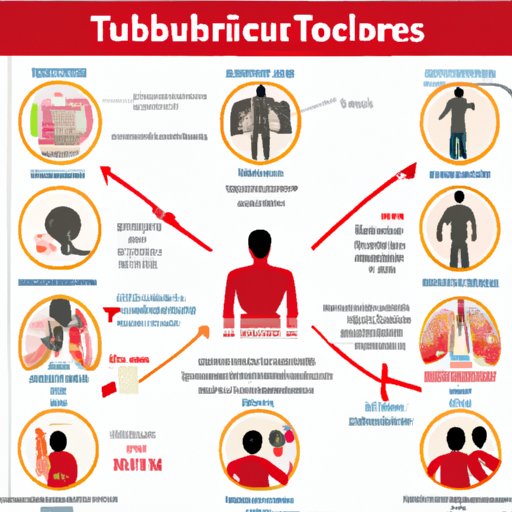
I. Introduction
Tuberculosis (TB) is a highly contagious and potentially life-threatening disease caused by bacteria. In this article, we will explore everything you need to know about TB disease, its symptoms, treatments, prevention, and psychosocial implications.
II. All You Need to Know About TB Disease: Causes, Symptoms, and Treatments
TB is primarily caused by Mycobacterium tuberculosis, which spreads through the air when an infected person coughs, sneezes or talks. The disease typically affects the lungs but can also spread to other body parts, including the brain, kidneys, and spine. Common symptoms of TB disease include coughing, chest pain, fatigue, weight loss, fever, and night sweats. If left untreated, TB can be fatal. However, many effective treatments and medications are available, including antibiotics and anti-tuberculosis drugs. It generally takes several months to treat TB disease effectively, and patients must finish the entire course of medication to avoid recurrence.
III. How to Prevent TB Disease: Tips for Staying Safe
To prevent TB disease, individuals must understand the risk factors and take preventative measures like vaccination, practicing good hygiene, and avoiding close contact with infected individuals. People who are at increased risk of contracting TB, such as those with weakened immune systems, should take extra precautions. Preventative strategies include vaccination of infants and children, screening programs, prompt and appropriate treatment of active TB, and managing latent TB infections. Proper ventilation, regular cleaning, and the use of face masks can also help prevent the spread of TB.
IV. TB Disease: A Global Health Crisis That Requires Immediate Attention
TB disease is a significant global health crisis, with an estimated 10 million people falling ill from TB in 2019. The majority of cases occur in low- and middle-income countries, with India, China, and Indonesia accounting for almost 50% of all cases. TB disproportionately affects vulnerable populations, including people living with HIV, children, and the elderly. The disease has significant economic and social implications, as it can lead to decreased productivity, increased healthcare costs, and lower life expectancy. Strategies for combating TB include increased funding and research, strengthening healthcare systems, expanding screening and vaccination programs, and improving access to effective treatments and medication.
V. Understanding the Stages of TB Disease and What to Expect
There are several stages of TB disease, including latent TB infection and active TB disease. During the latent stage, an individual carries TB bacteria that are inactive and asymptomatic. Latent TB is not contagious, but it can progress to active TB disease if left untreated. Active TB disease is when the TB bacteria become active and multiply, leading to symptoms and the potential to spread the infection to others. Early detection and treatment are critical to preventing TB disease from spreading or becoming severe. The treatment plan will vary depending on the stage and severity of the disease and may involve a combination of medications over several months.
VI. The History and Evolution of TB Disease: From Ancient Times to Modern Medicine
TB has been a significant public health issue since ancient times. The earliest recorded instance of TB is thought to date back to ancient Egypt in 2400 BCE. Throughout history, various treatments for TB have been developed, including surgical interventions and antibiotic medications. In the mid-20th century, new drugs were introduced that revolutionized TB treatment and significantly reduced mortality rates. Today, researchers continue to explore new treatments and more efficient ways to diagnose, prevent and treat TB, including developing vaccine candidates, new drugs and diagnostic tools.
VII. The Social and Psychological Impact of TB Disease: Coping with the Diagnosis and Beyond
Being diagnosed with TB disease can have a significant social and psychological impact on individuals and communities. Stigma, discrimination, and fear can accompany the diagnosis, which can create negative attitudes and mental health issues. TB treatments can also be challenging, as they may require individuals to take multiple medications over a long period, and side effects can be severe. People with TB disease may struggle with feelings of isolation and stigma, but support groups, counseling, and education can help people with TB disease manage the social and psychological aspects of their diagnosis.
VIII. Conclusion
TB disease continues to be a significant public health issue worldwide, but understanding the disease’s causes, symptoms, treatments, and impact is a crucial first step in curbing its spread. Encouraging vaccination, promoting good hygiene practices, expanding screening and treatment programs, and supporting research for new TB diagnostics, drugs and vaccines can all help reduce the burden of TB. For individuals with TB disease, early diagnosis and treatment, managing the emotional implications, and seeking support can help maximize their outcomes and quality of life.




